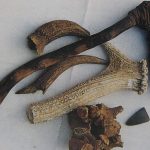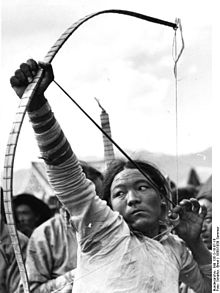What Primitive Hunting Requires?
What Primitive Hunting Requires?
1. Weapon
 To be successful with hunting, you must have the right weapons and be skillful in using them. This is the biggest challenge with primitive hunting.
To be successful with hunting, you must have the right weapons and be skillful in using them. This is the biggest challenge with primitive hunting.
Your prey is usually very fast and its senses are stronger than yours. Your defense must allow you to hit your prey at a distance and deliver a killing or disabling blow. There are several options that you can consider for this endeavor.
Throwing Stick
The simplest option for a weapon is a throwing stick. It’s a stick about 2 to 3 feet long, preferably with a large knot on one end. A good throwing stick can be landed accurately at about 30 to 40 yards.
With an end heavy design, it is thrown overhand and rotates as it approaches its target. It often disables prey without killing it. You must be prepared to rush in and deliver a killing blow in this case.
Spear
Spears are ideal for close quarter strikes but can also be thrown if needed.
If you are hunting a large animal, a single point is most useful to penetrate the vital organs. If you are shooting a smaller animal, then a four point spear is better to ensure that a point lands.
To make a four point spear, you need to split the point into four separate points and then shove small sticks into the gaps to spread out the points.
Either style of spear needs to be hardened in a fire to ensure the points penetrate. If you plan to throw the spear, you may want to add fletching at its end to help it fly true.
Spears are ideal for small game like frogs and fish or larger game such as wild hogs.
Atlatl
The atlatl is the next step in weapon evolution. It is a thin throwing spear with a new throwing arm to increase velocity and distance. These spears typically have to fletch, and the throwing arm has a notch on the end to hook to the end of the spear.
The additional distance that the throwing arm provides gives the same leverage you would get from having a longer arm. This allows accurate throws of up to 100 yards. It is best used for large game, but with practice can work on a smaller game as well.
Bow & Arrow
 The final step in primitive weapon evolution is the bow and arrow. It takes spring energy and transfers it from a string to an arrow. It can be fired with more accuracy than any other primitive weapon but is also the most difficult to build.
The final step in primitive weapon evolution is the bow and arrow. It takes spring energy and transfers it from a string to an arrow. It can be fired with more accuracy than any other primitive weapon but is also the most difficult to build.
The right type of wood must be used to ensure that the bow retains its spring without breaking. Locust or Osage orange trees are ideal for making bows. Once the bow is carved to shape, the string must be added. Then arrows must be crafted with fletching at one end and an arrowhead on the other.
Arrowheads can be fabricated from stone, glass, or metal. This allows the arrow to do significant damage to the prey when it strikes.
2. Stalking
One of the most forgotten aspect of hunting is the art of stalking prey. Because of high-powered rifles with scopes, most hunters no longer need to stalk their prey.
However, when hunting in a primitive nature, you must get closer without being noticed. This means tracking first their activity. You must be able to identify both tracks and scat to know where the animals are traveling. Game trails are another significant clue.
As you approach the prey, you must be able to remain hidden and silent. Camouflage’s hard in a survival situation. Usually, your best option is to cover yourself in mud and tuck small leafy branches into your clothing wherever possible.
You can cover your scent by rubbing ash from your fire on your body or using other natural scents such as pine or spruce needles. To feel twigs and leaves under your feet, you should hunt barefoot so you can stay silent.
Cost VS Benefit
Calories Spent
When hunting, you typically are very active. Sure there are types of hunting where you sit on a tree stand all day, but that is not primitive hunting.
To collect your meal, you must walk the woods all day until you find you prey. This requires you to expend thousands of calories. You are also risking injury as you might trip and fall, twist an ankle, or get bitten by a snake.
Then, if you do kill an animal, you must use more calories gutting and cleaning it for preparation.
Using All the Meat
One of the largest challenges of primitive hunting is ensuring that you get to benefit from all of the meat.
If you kill a wild hog and do not have a method by which to preserve the meat, you have only provided yourself with one meal.
To ensure that you avoid this problem, you should be skilled in drying meat before you are faced with a survival scenario. With these tactics, you can save your meat for weeks without it spoiling.
Will I Get Anything?
This is the big question when it comes to hunting. The odds are definitely against you.
If you decide to hunt with primitive weapons, it is very likely that you will be coming home empty handed. The chances of finding prey within firing range and hitting that prey are small — meaning, you may come back without any food.
There are two primary problems with this:
- You have expended a significant amount of calories without consuming any calories.
- You are creating frustration that you did not have previously. Morale is a huge deal when it comes to survival.
Concluding Thoughts
In this discussion of primitive hunting versus other types of food procurement, I have to say that active hunting is a bad idea in most cases given these reasons:
- You risk a great deal when you go out hunting.
- You consume calories building weapons and you use up more as you hunt.
- You risk your safety as you walk through the wilderness.
- You face the odds of likely not coming home with any food.
I feel that there are better ways to get food. Sure it is nice to think that you can take a walk in the woods and come back with meat for days, but it just does not work that way.
Survival is not a television show. There are situations where hunting might make sense but typically, there are better ways to find food. I have been in several survival situations and have only been able to successfully hunt for food in a few of those circumstances.
What matters most is that you analyze the situation. If you have easy prey and an effective weapon, you might have a chance. When it comes right down to it, you must find food one way or the other.
If hunting is your option, then go with it. If not, go another route. Either way, finding protein is essential. When the time comes that you must rely on these methods for finding food, consider your choice and select what makes the most sense.
This Article Written By Almo Gregor
Editor at outdoorempire.com
Benefit cost hunting Primitive Stalking weapon What Primitive Hunting Requires?

